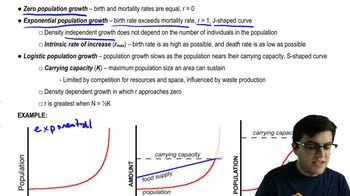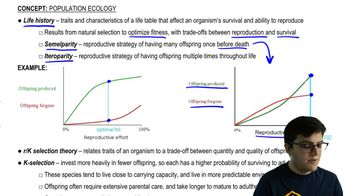Over the last century, the human population size and growth rate has exploded. We went from a world where there was never more than 2,000,000,000 humans ever, to now a world where there's nearly 8,000,000,000 people on the planet, and that is rising. In fact, if you're curious, here are some estimates from the UN as to population increases in the coming century. Now it's important to remember that just like there's a carrying capacity in nature, there's a carrying capacity for humans, and there is a limit to global carrying capacity for the human population. Although, estimates for what this is vary. And additionally, that could change based on technological advances. However, the point is we need to be conscious about our ecological footprint, which is the amount of land needed to sustain an organism or a population's use of resources. So if we think about it in terms of an individual there's going to be a certain amount of land that person needs to provide them with the necessary nutrients, right, food and whatnot. Also, that individual is going to generate waste. There needs to be a certain amount of space for that waste to go, so that that person doesn't kill themselves with their own waste. I mean, these are just two examples. But the point is we need to think about our use of this earth, and how sustainable our lifestyles are. Because this is unsustainable. As we saw with our logistic growth model previously, previously, there is a carrying capacity. We just haven't hit it yet. Now I don't mean to fear monger anything, but those are important things to think about. However, moving on, I'm going to talk about demographic transitions. This is maybe getting a little more into sociological territory, but this is a transition from high birth rate and high death rates to low birth rates and low death rates. So, essentially, this is why you see, you know, what are often referred to as developing nations, have many more young people than older people because their birth rates are high and their death rates are high. In more developed nations, we have lower birth and death rates, and so our age pyramids, instead of looking like that, look more like this. Because there's just a higher survival for a large range of angels. Now the fertility rate is the average number of surviving children each woman has in her lifetime. And this factors into what we call the replacement rate, which is the fertility rate required for women to give birth to enough children to sustain the population. And this is something we're thinking about in developed nations now, because as we can see, for example, in places like Japan, their population is decreasing because their replacement rate is, well, not high enough. They're not sustaining their population, their fertility rate is too low. Generally speaking, I should say, replacement rate is about 2.1. Because if you think about it, you have and and this is for developed nations, I should say, this is like US, you know, if you think about it, a woman would have to give birth to 2.1 children. Basically, that's saying that most women need to give birth to 2 children which will replace themselves and, you know, their partner. And, you know, this point one is basically because there's, you know, a chance that not all of these people are going to make it to the age where they can reproduce. You know, they're not going to make it all the way through that generation time. So that's why it's 2.1. But basically, you could almost just think of it as 2 to replace each parent. Alright. With that, let's call it a day. That's all I have for this lesson. See you guys next time.
Table of contents
- 1. Introduction to Biology2h 40m
- 2. Chemistry3h 40m
- 3. Water1h 26m
- 4. Biomolecules2h 23m
- 5. Cell Components2h 26m
- 6. The Membrane2h 31m
- 7. Energy and Metabolism2h 0m
- 8. Respiration2h 40m
- 9. Photosynthesis2h 49m
- 10. Cell Signaling59m
- 11. Cell Division2h 47m
- 12. Meiosis2h 0m
- 13. Mendelian Genetics4h 44m
- Introduction to Mendel's Experiments7m
- Genotype vs. Phenotype17m
- Punnett Squares13m
- Mendel's Experiments26m
- Mendel's Laws18m
- Monohybrid Crosses19m
- Test Crosses14m
- Dihybrid Crosses20m
- Punnett Square Probability26m
- Incomplete Dominance vs. Codominance20m
- Epistasis7m
- Non-Mendelian Genetics12m
- Pedigrees6m
- Autosomal Inheritance21m
- Sex-Linked Inheritance43m
- X-Inactivation9m
- 14. DNA Synthesis2h 27m
- 15. Gene Expression3h 20m
- 16. Regulation of Expression3h 31m
- Introduction to Regulation of Gene Expression13m
- Prokaryotic Gene Regulation via Operons27m
- The Lac Operon21m
- Glucose's Impact on Lac Operon25m
- The Trp Operon20m
- Review of the Lac Operon & Trp Operon11m
- Introduction to Eukaryotic Gene Regulation9m
- Eukaryotic Chromatin Modifications16m
- Eukaryotic Transcriptional Control22m
- Eukaryotic Post-Transcriptional Regulation28m
- Eukaryotic Post-Translational Regulation13m
- 17. Viruses37m
- 18. Biotechnology2h 58m
- 19. Genomics17m
- 20. Development1h 5m
- 21. Evolution3h 1m
- 22. Evolution of Populations3h 52m
- 23. Speciation1h 37m
- 24. History of Life on Earth2h 6m
- 25. Phylogeny2h 31m
- 26. Prokaryotes4h 59m
- 27. Protists1h 12m
- 28. Plants1h 22m
- 29. Fungi36m
- 30. Overview of Animals34m
- 31. Invertebrates1h 2m
- 32. Vertebrates50m
- 33. Plant Anatomy1h 3m
- 34. Vascular Plant Transport2m
- 35. Soil37m
- 36. Plant Reproduction47m
- 37. Plant Sensation and Response1h 9m
- 38. Animal Form and Function1h 19m
- 39. Digestive System10m
- 40. Circulatory System1h 57m
- 41. Immune System1h 12m
- 42. Osmoregulation and Excretion50m
- 43. Endocrine System4m
- 44. Animal Reproduction2m
- 45. Nervous System55m
- 46. Sensory Systems46m
- 47. Muscle Systems23m
- 48. Ecology3h 11m
- Introduction to Ecology20m
- Biogeography14m
- Earth's Climate Patterns50m
- Introduction to Terrestrial Biomes10m
- Terrestrial Biomes: Near Equator13m
- Terrestrial Biomes: Temperate Regions10m
- Terrestrial Biomes: Northern Regions15m
- Introduction to Aquatic Biomes27m
- Freshwater Aquatic Biomes14m
- Marine Aquatic Biomes13m
- 49. Animal Behavior28m
- 50. Population Ecology3h 41m
- Introduction to Population Ecology28m
- Population Sampling Methods23m
- Life History12m
- Population Demography17m
- Factors Limiting Population Growth14m
- Introduction to Population Growth Models22m
- Linear Population Growth6m
- Exponential Population Growth29m
- Logistic Population Growth32m
- r/K Selection10m
- The Human Population22m
- 51. Community Ecology2h 46m
- Introduction to Community Ecology2m
- Introduction to Community Interactions9m
- Community Interactions: Competition (-/-)38m
- Community Interactions: Exploitation (+/-)23m
- Community Interactions: Mutualism (+/+) & Commensalism (+/0)9m
- Community Structure35m
- Community Dynamics26m
- Geographic Impact on Communities21m
- 52. Ecosystems2h 36m
- 53. Conservation Biology24m
50. Population Ecology
Introduction to Population Ecology
Video duration:
4mPlay a video:
Related Videos
Related Practice


































































